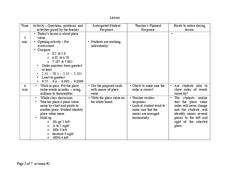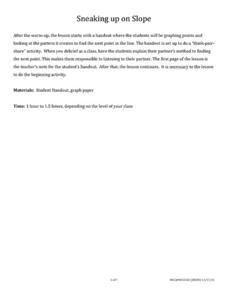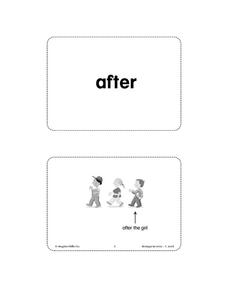Curated OER
Where Math Meets Poetry
Students identify Fibonacci's sequence of numbers and use the pattern to write poetry with one syllable words. In this math and writing lesson, students identify Fibonacci's sequence of numbers and learn about this early mathematician....
Curated OER
Inductive Reasoning
In this algebra instructional activity, 10th graders apply inductive reasoning as they figure out the next number in the sequence or pattern. There are 53 problems.
Curated OER
Place Value
Practice place value skills with this lesson. Learners put numbers in order from greatest to least, identify the values of particular numbers, and engage in an activity to compare numbers using manipulatives.
Curated OER
The Clumsy Tiler N (Fractions)
Learners explore patterns and geometric sequencing. Students devise and use problem solving strategies to explore situations mathematically. Learners solve real life problems. They demonstrate, with cardboard pieces, fraction and...
Curated OER
The Clumsy Tiler N (Metric)
Students explore patterns and geometric sequencing. Students devise and use problem solving strategies to explore situations mathematically. Students solve real life problems. They demonstrate, with cardboard pieces, fraction and...
Curated OER
Mixed Fraction Sequences
In this math learning exercise, students complete the mixed fractions that are sorted into a sequence. The sheet is intended as a teacher's guide.
Curated OER
Decimal Sequences
In this math worksheet, students solve the problems that are intended to focus upon he sequences of decimals. The sheet is a teacher's guide.
Curated OER
Stoplight Problem Solving
In this problem solving instructional activity, students use the six different columns to create six different patterns for the red, yellow, and green lights for a stop light.
Curated OER
No-Three-In-A-Line Again
Learners interpret information and results in context while using words and symbols to generalize patterns. They use symmetry and angle properties of polygons to solve practical problems and identifying invariant properties under...
Virginia Department of Education
Weather Patterns and Seasonal Changes
Get your class outside to observe their surroundings with a lesson highlighting weather patterns and seasonal changes. First, learners take a weather walk to survey how the weather affects animals, people, plants, and trees during...
Illustrative Mathematics
Find The Numbers 0-5 or 5-10
In need of math station or center for your kindergartners? Model how to play this game with the whole class first and then make it into a center. Create a few sets of six number cards with 0-5 or 5-10 and then create a matching die with...
Curated OER
Genes, DNA, and Mutations
With paper DNA patterns, budding biologists model translation and base-pair substitution within sequences. Through these activities, they examine how mutations can result in genetic disorders. The modeling that occurs is an enlightening...
West Contra Costa Unified School District
Sneaking Up on Slope
Pupils determine the pattern in collinear points in order to determine the next point in a sequence. Using the definition of slope, they practice using the slope formula, and finish the activity with three different ways to...
Curated OER
Philippine Banig Weaving
Students create a Philippine banig mat. As part of designing and creating the mat, the class is introduced to the tropical rain forest of the Philippines and how the environment impacts the lives of the people. Individuals also discover...
Curated OER
Surfin' USA Lummi Stick Routine
"Let's go surfin' now, everybody's learning how, come on and safari with me." One of the Beach Boys more famous songs that is bound to get your class up and moving. This dance has basic dance steps and the added dimension of using Lummi...
Illustrative Mathematics
How Many _______ Are In. . . ?
Help your learners gain meaningful understanding of dividing fractions using fraction models. The activity includes nine problems which are sequenced to show how the fraction division algorithm evolves. Have students use graph paper or...
EngageNY
When Can We Reverse a Transformation? 2
The second lesson on finding inverse matrices asks class members to look for a pattern in the inverse matrix and test it to see if it works for all matrices. The teacher leads a discussion to refine the process in finding inverses,...
American Museum of Natural History
Horse Gaits Flipbooks Walk, Trot, and Gallop!
Scholars follow seven steps to create horse-themed flipbooks. Three printable options allow them to choose from walking, trotting, or galloping scene.
DK Publishing
Sneaky Snake: Numbers
Find the numbers that the sneaky snakes are hiding! Using a number table, primaries determine which numbers are covered up by snakes. They write in the numbers next to the matching snake below the table, which reinforces both...
02 x 02 Worksheets
Inverse Variation
Discover an inverse variation pattern. A simple lesson plan design allows learners to explore a nonlinear pattern. Scholars analyze a distance, speed, and time relationship through tables and graphs. Eventually, they write an equation to...
Curated OER
Multiples
A great worksheet for scaffolding critical thinking about mathematical concepts. This resource provides students with a brief explanation of multiples followed by 29 practice problems which gradually increase in difficulty. Several...
Curated OER
Dot Plots
Number crunching statisticians explore displaying data with dot plots and define the difference between quantitative data and qualitative data. Dot plots are created based on a set of given data and analyzed.
Houghton Mifflin Harcourt
Unit 4 Math Vocabulary Cards (Grade K)
In need of a set of math vocabulary cards for beginning mathematicians? Use a resource that contains 15 vocabulary cards. The top half of each sheet has the word printed in bold text, while the bottom is a picture representing the...
Curated OER
Counting by 2s, part 2
Two, four, six, eight...can your scholars count by twos? They fill in missing numbers in 18 number sequences, all of which require skip counting by twos. Some begin on an even number and others odd, however all of these are whole...






















